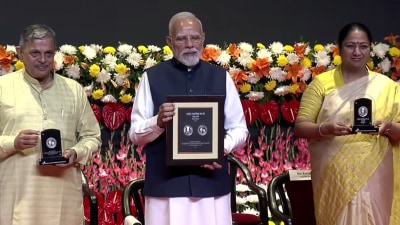Ritu Sarin is Executive Editor (News and Investigations) at The Indian Express group. Her areas of specialisation include internal security, money laundering and corruption. Sarin is one of India’s most renowned reporters and has a career in journalism of over four decades. She is a member of the International Consortium of Investigative Journalists (ICIJ) since 1999 and since early 2023, a member of its Board of Directors. She has also been a founder member of the ICIJ Network Committee (INC). She has, to begin with, alone, and later led teams which have worked on ICIJ’s Offshore Leaks, Swiss Leaks, the Pulitzer Prize winning Panama Papers, Paradise Papers, Implant Files, Fincen Files, Pandora Papers, the Uber Files and Deforestation Inc. She has conducted investigative journalism workshops and addressed investigative journalism conferences with a specialisation on collaborative journalism in several countries. ... Read More
Dubey probably right, experts on job: CBI to SC
More than 15 months after Satyendra Dubey’s murder, the Central Bureau of Investigation (CBI) has sought the help of experts to technic...

More than 15 months after Satyendra Dubey’s murder, the Central Bureau of Investigation (CBI) has sought the help of experts to technically scrutinise the very issues of contract violations and financial impropriety which the NHAI engineer, while working on a Bihar stretch of the Golden Quadrilateral highway project, tried to expose while he was alive.
The CBI’s status report to the Supreme Court—it was taken up by the apex court today—reveals that the agency has appointed a panel of top experts from the Ministry of Road Transport and Highways, the Indian Institute of Technology and the Central Road Research Institute to conduct a technical scrutiny of Package VB of the Golden Quadrilateral.
It was about corruption on this stretch that Dubey had complained to the Prime Minister’s Office (PMO) with the request that his identity be kept secret. Shortly after his murder in Gaya on the night of November 27, 2003, The Indian Express was the first to report that Dubey’s cover had been blown.
Now the CBI says that Dubey was probably right about unauthorised sub-contracting of work.
‘‘This is a very complex case involving construction of a sophisticated road work requiring examination of various technical issues by the experts in the field. The investigation so far gives prima facie indication of sub-contracting of the road work by the main contractor to unapproved agencies,’’ the CBI’s status report states.
The panel of road engineers are expected to reach the highway site on March 17 and are to file a report for the CBI on the quality of construction done by the sub-contractors as well as collect samples for technical examination.
On September 26, 2004, the CBI had filed its FIR in the case naming, among others, Dubey’s senior, NHAI Project Director, S K Soni in the highway scam. The status report now elaborates on the role played by each of the persons named in the FIR and establishes how the entire Rs 434-crore GQ project had been sub-contracted, despite NHAI’s permissible limit for sub-contracting being a mere 10 per cent.
The CBI has stated that its investigations have revealed that the GQ package was ‘‘immediately’’ sub-contracted, throwing to the winds the complicated tendering process and quality control parameters of the NHAI.
The agency has concluded that, ‘‘immediately after the award of contract by NHAI to M/s L&T-HCC (Joint Venture) on March 26, 2002, M/s L&T started negotiations with different sub-contractors for off loading the work to them on a back-to-back basis.’’
While the CBI had not named L&T officials—it was the lead partner in the GQ contract—in its FIR, they have now admitted that the company had ‘‘misrepresented facts’’ while submitting their proposal for sub-contracting to the NHAI in October 2002.
The apex court has been informed how ‘‘it was indicated that only the labour component for these two items of work would be sub-contracted, whereas, they had already entered into sub-contract agreements for transportation, laying and compaction of these items.’’
The CBI reveals how Dubey had, in June 2003, ‘‘apprised the Supervision Consultant about the unauthorized subcontracting by M/s L&T in Package VB. A copy of the letter was endorsed to S K Soni. However, S K Soni simply filed this letter and did not take any action. Brig Satish Kapoor (also named in the FIR), who was the Resident Engineer of the Supervision Consultant, also did not take any action in the matter.’’
The CBI has admitted that their evidence in the case now runs into thousands of pages and that the technical spot examination about to be undertaken was unprecedented.
The status report highlights how shortly before the CBI filed its FIR, the NHAI also appointed a high-level committee to examine ‘‘falsifications’’ done by M/s L&T and that J Ganguly, the firm’s Executive Vice President who had signed the contract with NHAI, had been questioned by the CBI. The explanation given by him will also be scrutinized by the experts panel appointed by the CBI.



- 01
- 02
- 03
- 04
- 05





























